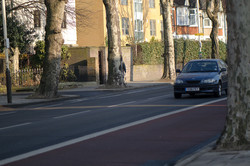Gadget Infinity Cactus V2 radio trigger antenna extension mod
Gadget Infinity is an online shop based in Hong Kong specialized in electronic gadgets that truly reflects the sophisticated design of every tiny invention. They provide a wide range of electronic goods for digital cameras such as batteries, charger, flashguns, GPS adapter, wireless shutter, wireless flash triggers etc...
One of their most popular product is the Cactus V2 and V2s, a cheap flash radio trigger that allows you to wirelessly remote trigger your speedlight. When the pro top level radio triggers (Pocket Wizard) cost around £300 the set of transmitter and receiver, the GI Cactus triggers cost around £22.
The down side of these cheap triggers is their reliability and range. Their range is variable, some photographers did witness a range of 45 meters, on the field I've noticed a max range of 4 meters on my ones. Depending whether you shoot indoors or outdoors and if you are close from any radio interference they can be more or less reliable, but often you will notice lots of misfires.
But then more and more photographers that happen to also be DIYers posted article on some antenna extensions mod to these 'el cheapo' triggers. A lot of them claimed that the mod has doubled or even quadrupled the trigger's range.
There are two type of antenna extension mods for the Cactus V2s radio triggers:
- the external antenna extension
- the internal antenna extension
For my trigger, I've opted for the internal one which to me looks cleaner and also easier to do.
I'm not going to rewrite a whole tutorial from scratch when there are a bunch out there on the Internet. To resume, what you need is a solder iron, a lead solder, a screwdriver, a thin pencil and a copper wire (bare or insulated). The copper wire needs to be 12.39 inches long and can be taken from a single core Cat5e cable (RJ45 network cable). I don't have any single core so I took the core of a TV aerial cable. That copper wire is insulated with a thick plastic insulation material that I've removed by burning it (be careful the plastic is very inflammable and melts, do it at your own risk as I won't be held responsible of any accident), that is why you can see on the picture that the copper wire is not shiny and its color is not even. Use the thin pencil to make a coiled copper wire which is going to be the antenna soldered on the left side of the board inside the trigger.
For more details have a look at those two tutorials:
GI Cactus Antenna Mod Test #1
After the modification of my Cactus V2s trigger, I've done a test. I've asked my wife to stay in the living room of our 3rd floor flat and went down outside the building calling her on the mobile phone she was to tell me whenever the Cactus V2s LED blinks:
- my wife in the living room, door closed. I'm inside the loo, door closed. The receiver blinked.
- I start to go down. Outside the flat on 3rd floor: blink.
- Down the ground floor: blink.
- I went around the building on the main street facing the living room's window: blink!
- I went to the back of the building by the car park 20 meters away from the building entrance: no blink...
- I stepped forward and the receiver started to blink when I was half way back to the entrance.
Conclusion: not bad at all! The trigger signal went thru all the walls and doors to the receiver in the living room. Of course testing by pressing on the test button is not the best way to do it. But at least I know that the signal is being sent all the way. I will soon do a proper reliability test and will post it here.
Update - GI Cactus Antenna Mod Test #1 (Friday 09 January)
I went at lunch time doing another test for this antenna mod. This time instead of pressing the test button of my Cactus trigger, I've set the trigger on my Nikon D300 and did the shot with a 105mm lens. I've set a lightstand in my room (3rd floor flat) with a Sunpak 383s on it triggered by the Cactus receiver using the mini PC Sync cord.
Then I went down stairs, crossed the road and took a serie of pictures from the pavement on the other side of the road in front of my building:
- The first shot above shows were will be my shooting point
- Then a view on the street on my right from my shooting point.
- A view on my room's window without the Cactus transmitter. Circled in red is where my flashgun is.
- Then a successful first shot with the Cactus transmitter on the camera.
I did take 29 shots with the transmitter on the camera and out of those 29 shots, only 1 misfire!
The distance between my shooting point and the bottom of my building at approximately my flash's level is about 60 ft. I started to get a bit of misfires when going further back.
Update
There are now better radio triggers (more reliable, better range etc...) few examples are: CTR-301P, RF 602 and the soon to be released Phottix Atlas that will be compatible with the Pocket Wizards.













Comments
blink does not equal flash
Thursday 08 January 2009 8:41:29 am
Commented by Richard
More testing will be done
Friday 09 January 2009 12:43:10 pm
Commented by Quoc Huy Nguyen Dinh